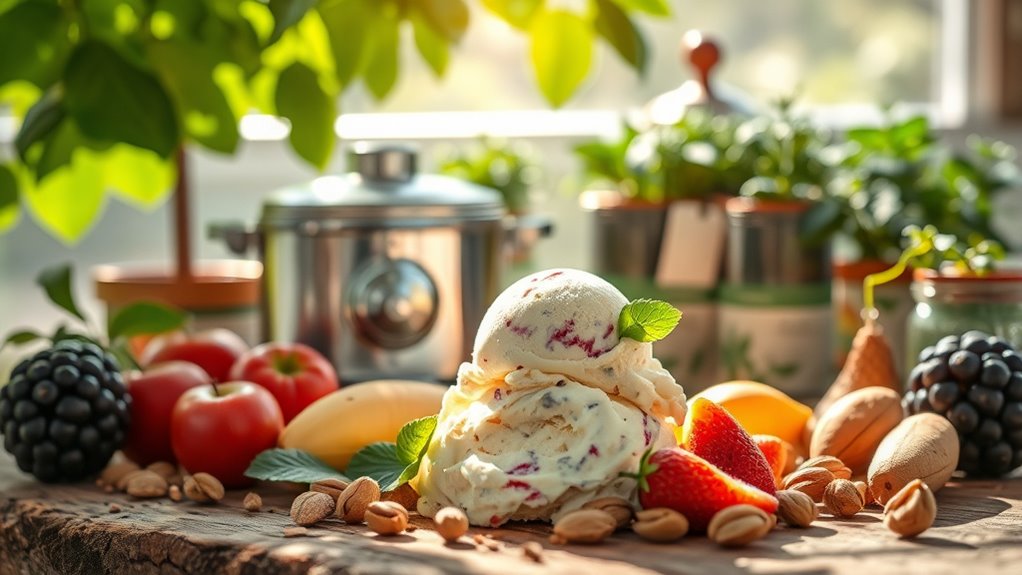Sustainability in ice cream production is essential for reducing environmental harm while meeting consumer demands. Traditional methods create significant greenhouse gas emissions, primarily from dairy farming and energy use. By choosing organic, local, and plant-based ingredients, and adopting eco-friendly packaging, you can help minimize your carbon footprint. Brands like Jude’s Ice Cream and Northern Bloc are leading the way in sustainable practices. Discover how you can make informed choices that support a greener future in ice cream.
Key Takeaways
- Sustainable ice cream production focuses on sourcing organic, local, and fair-trade ingredients to reduce environmental impact and meet consumer demand.
- Traditional ice cream manufacturing significantly contributes to greenhouse gas emissions and requires substantial water and energy resources.
- Plant-based ice cream options offer a lower carbon footprint compared to traditional dairy products, promoting sustainability.
- Innovative packaging solutions, such as recyclable cartons and edible cutlery, are essential for reducing waste and enhancing brand reputation.
- Consumer support for sustainable brands can drive responsible practices and foster environmental stewardship in the ice cream industry.
The Importance of Sustainability in Ice Cream Production

Sustainability in ice cream production is essential not just for the environment, but also for meeting consumer demand. With 81% of consumers believing companies should help the environment, adopting sustainable production methods is a must.
Traditional ice cream contributes to significant greenhouse gas emissions, primarily from dairy farming. By prioritizing organic, local, and fair-trade ingredients, you can help reduce this environmental impact.
Additionally, embracing sustainable packaging solutions minimizes waste and lowers your carbon footprint. Innovative practices like upcycling rejected fruits into ice cream can tackle food waste, which contributes to 8% of human-caused greenhouse gas emissions.
Shifting to sustainable refrigeration methods, such as CO2 freezers, further enhances energy efficiency and reduces the environmental impact of your ice cream production. Furthermore, utilizing freshly squeezed juices can enhance flavors while supporting sustainable sourcing practices.
Environmental Impact of Traditional Ice Cream Manufacturing

When you consider traditional ice cream manufacturing, it’s hard to ignore its significant environmental footprint.
Dairy farming alone contributes around 4% of global greenhouse gas emissions and strains water resources, requiring about 1,000 liters of water for just 1 liter of milk.
Coupled with the energy-intensive refrigeration process, the impact on our planet is substantial and calls for urgent attention.
Greenhouse Gas Emissions
Ice cream production is a surprisingly significant contributor to greenhouse gas emissions, with dairy farming alone accounting for about 4% of global emissions.
This impact on climate change is exacerbated by the energy consumption required for refrigeration. The use of hydrofluorocarbons (HFCs) in cooling processes releases potent greenhouse gases, further intensifying global warming.
Additionally, cold chain logistics, crucial for maintaining ice cream quality, contribute up to 10% of worldwide CO2 emissions during transportation and storage.
To combat these issues, adopting sustainable agricultural practices can help minimize emissions from dairy farming.
You can also seek brands that prioritize eco-friendly packaging to reduce landfill waste, making a positive impact on the environment while enjoying your favorite treat.
Water Resource Depletion
Water resource depletion is a pressing issue in traditional ice cream manufacturing, with the production of just 1 liter of milk requiring an astonishing 1,000 liters of water. This strain on our water supplies raises significant concerns for environmental sustainability.
Consider these points:
- Dairy farming contributes about 4% of global greenhouse gas emissions, exacerbating global warming.
- Increased ice cream production leads to heightened competition for limited water resources.
- The cooling and cleaning processes in ice cream manufacturing further stress local water availability.
- Rising consumer demand for ice cream amplifies the water footprint, threatening long-term water resource management.
Addressing these challenges is vital for achieving a sustainable future in ice cream production without compromising our water resources.
Sustainable Practices in Ice Cream Production

When you think about sustainable ice cream production, consider how sourcing eco-friendly ingredients can make a difference. Companies are also focusing on sustainable packaging solutions to cut down on waste. Plus, energy-efficient production methods help reduce the carbon footprint, making your favorite treat a little greener. Additionally, many ice cream brands are exploring vegan and dairy-free options to cater to the growing demand for healthier, sustainable alternatives.
Eco-Friendly Ingredients Sourcing
Sourcing eco-friendly ingredients is crucial for creating a sustainable ice cream production process. By choosing the right ingredients, you can considerably reduce the environmental impact of your ice cream.
Here are four key practices to take into account:
- Opt for organic and local ingredients: This minimizes transportation emissions and supports sustainable farming.
- Incorporate plant-based options: These can lower your overall carbon footprint compared to traditional dairy.
- Utilize upcycled ingredients: Using rejected fruits helps reduce food waste and promotes sustainability.
- Partner with responsible initiatives: Collaborate with programs like the Sustainable Vanilla Initiative to guarantee ethical sourcing.
Additionally, implementing raw food diets can inspire innovative ingredient choices that contribute to both sustainability and nutrition.
These practices not only make your ice cream greener but also contribute to a healthier planet.
Sustainable Packaging Solutions
As consumers become more environmentally conscious, the demand for sustainable packaging solutions in ice cream production is growing. Brands like Sacred Serve are leading the way with 100%-recyclable cartons, demonstrating that you can enjoy your favorite treat while being kind to the planet.
Ben & Jerry’s is set to eliminate petroleum-based plastic by 2025, aiming for 100% sustainable packaging. Meanwhile, Planet Foods uses eco-friendly sugar-cane packaging, greatly reducing plastic waste.
IncrEDIBLE Eats takes it a step further with edible cutlery, offsetting 200% of their emissions and plastic footprint. The shift towards paper-based, upcycled, and plastic-free options is vital as you demand more environmentally friendly choices in your ice cream products. Additionally, incorporating natural materials in packaging can further enhance sustainability efforts and reduce environmental impact.
Energy-Efficient Production Methods
Sustainable packaging solutions are just one part of the broader movement towards greener practices in ice cream production.
You can further enhance sustainability by focusing on energy-efficient production methods. Here are four ways to optimize your production process:
- Implement CO2 freezers that reduce energy use and improve efficiency.
- Adopt renewable energy sources to power your manufacturing facilities.
- Utilize low-carbon technologies that lower operational costs while minimizing environmental impact.
- Optimize energy usage throughout the production process to reduce overall demand.
Innovative Technologies for Eco-Friendly Ice Cream

While many people enjoy ice cream, the industry is rapidly evolving to embrace innovative technologies that prioritize eco-friendliness. CO2 freezers are transforming production by using non-toxic refrigerants, greatly cutting energy consumption and environmental impact. These freezers enable continuous freezing methods, enhancing energy efficiency and improving ice cream texture, making it creamier and more enjoyable. Many companies are investing in energy-efficient practices, optimizing refrigeration systems, and harnessing renewable energy to lower their carbon footprints. Additionally, heat pumps can be integrated into production processes to further reduce energy bills and overall environmental impact. The adoption of renewable energy technologies not only supports sustainable practices but also contributes to financial growth through long-term savings on energy bills.
Upcycling initiatives, like those from Salt & Straw and Takay, creatively repurpose rejected ingredients, minimizing food waste while introducing unique flavors. Additionally, sustainable packaging innovations, such as Ben & Jerry’s commitment to eliminate petroleum-based plastics by 2025, are essential for reducing landfill waste and enhancing environmental sustainability.
Leading Brands in Sustainable Ice Cream

The ice cream industry is seeing a shift toward brands that prioritize sustainability alongside flavor.
Here are four leading brands making a difference:
- Northern Bloc – Specializes in plant-based ice cream, using natural ingredients and fully sustainable packaging to reduce environmental impact.
- Jude’s Ice Cream – The first carbon-negative ice cream brand, sourcing local ingredients and participating in tree planting initiatives.
- The Coconut Collaborative – Offers dairy-free ice creams made from ethically sourced coconut milk, packaged in eco-friendly materials.
- Sacred Serve – Creates 100%-recyclable, plastic-free cartons, showcasing innovative sustainable packaging solutions.
Consumer Responsibility and the Future of Ice Cream Sustainability

How can your choices as a consumer shape the future of ice cream sustainability? By prioritizing brands that embrace sustainability, you can drive change in the ice cream industry.
With 81% of consumers urging companies to help the environment, your purchasing decisions matter. Look for ice cream brands using organic, local, and fair-trade ingredients, along with eco-friendly ice cream packaging. These choices not only reduce greenhouse gas emissions but also promote environmental stewardship.
Your purchasing decisions can drive sustainability; choose ice cream brands with organic, local, and eco-friendly practices.
As the global ice cream market grows, your support for sustainable options encourages brands to innovate responsibly. Collaborative change is essential; when consumers and brands align on sustainability, it builds trust and loyalty, fostering a healthier planet for everyone. Additionally, prioritizing brands that adhere to privacy policies can enhance your overall shopping experience and ensure your data is handled responsibly.
Your voice is powerful—use it wisely!
Frequently Asked Questions
How Is Ice Cream Sustainable?
Ice cream can be sustainable through various practices. You can choose brands that prioritize organic, local ingredients to reduce environmental impact.
Look for companies using renewable energy in their production processes. When you opt for ice cream made with upcycled ingredients, you’re helping to minimize food waste.
Additionally, selecting products with recyclable or plastic-free packaging can further lessen landfill contributions.
How to Make Ice Cream More Sustainable?
Did you know that dairy farming contributes about 4% of global greenhouse gas emissions?
To make ice cream more sustainable, you can start by choosing brands that prioritize organic and local ingredients.
Opt for ice cream packaged in recyclable materials and consider plant-based options, which typically have a lower environmental impact.
Supporting companies that use renewable energy in production processes also helps.
Finally, participate in initiatives that upcycle rejected ingredients into delicious treats.
What Is Ben and Jerry’s Sustainability Strategy?
Ben & Jerry’s sustainability strategy focuses on eliminating petroleum-based plastics from packaging by 2025 and sourcing Fairtrade certified ingredients.
They actively reduce their carbon footprint through a carbon neutrality initiative and support regenerative agriculture to improve soil health.
Additionally, they engage in climate justice activism, advocating for policies that combat climate change.
What Are the Ethical Issues With Ice Cream?
You might think of ice cream as a simple treat, but beneath its creamy surface lie serious ethical issues.
From labor abuses in vanilla and cocoa production to the environmental impact of dairy farming, the industry faces significant challenges. Child labor and harsh working conditions contrast starkly with the joy ice cream brings.
Additionally, sourcing ingredients like palm oil often leads to deforestation, raising questions about your favorite flavors and their broader implications.
Conclusion
In embracing sustainability in ice cream production, you’re not just savoring a treat; you’re supporting a healthier planet. By choosing brands that prioritize eco-friendly practices, you’re fostering a brighter future for our children and our environment. As you enjoy each delightful scoop, remember that your choices matter. Together, we can create change, inspire innovation, and celebrate the joy of ice cream while caring for our Earth. Let’s indulge responsibly, because every bite counts in this sweet journey toward sustainability.










